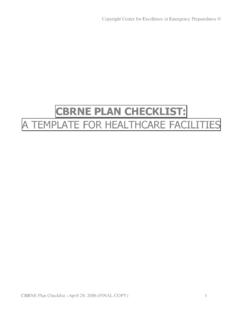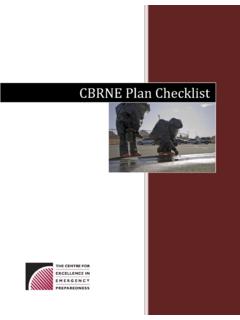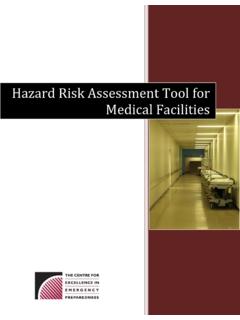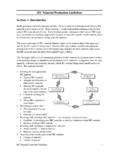Transcription of An Introduction to Mass Gatherings
1 Centre for Excellence in Emergency Preparedness . An Introduction to mass Gatherings Daniel Kollek MD, CCFP (EM). June, 2014. Centre for Excellence in Emergency Preparedness . Introduction to mass Gatherings Contents Introduction TO mass Gatherings .. 2. MEDICAL CARE AT mass Gatherings .. 3. GENERAL 3. 1. Surveillance .. 3. 2. Prevention .. 3. 3. Diversion .. 4. ANTICIPATING HUMAN RESOURCES REQUIREMENTS.. 7. COMMAND-AND-CONTROL 10. EQUIPMENT AND SUPPLIES.. 10. LAYOUT OF THE MEDICAL DELIVERY SYSTEM.. 11. ACCESS TO PATIENTS .. 12. DOCUMENTATION PLAN.. 13. References .. 15. 1. Centre for Excellence in Emergency Preparedness.
2 Introduction TO mass Gatherings . Daniel Kollek MD, CCFP (EM). Centre for Excellence in Emergency Preparedness . There are a variety of definitions of mass gathering in the literature ranging from 1000 to 25000. people1 however the accepted definition is a temporary collection of at least 1000 persons gathered at a specific location for a defined period of time for a common purpose".2,3,4 The duration of mass Gatherings can last anywhere from one hour to several days or weeks. Despite the fact that these events are typically self triaged [with people who are ill usually staying away] they generate a higher incidence of injury and illness then the general population statistics.
3 5. In the post-9/11 world there also is increased needs to consider catastrophic attacks or accidents in other environments that are virtual mass Gatherings and, as such, are potential sites for mass casualties. These could include airports [for example the recent LAX shootings], large shopping complexes [the recent Kenyan shopping mall terrorist attack], mass transit etc. As such it is important for all members of the emergency medical system to have an understanding of mass gathering events. Furthermore mass gathering provides a practical opportunity to prepare for mass casualty events and improve the level of disaster preparedness at the municipal provincial and national Multiple factors have been identified that influence the demand for healthcare during such an event.
4 The key identifiable modifiers are: Weather [temperature and humidity Duration of the event Whether the event is predominantly outdoors or indoors Whether the crowd is predominantly seated or mobile Whether the event is bounded [ fenced or contained] or unbounded The type of event The availability of alcohol and presumptive availability of drugs The mood of the crowd Crowd density/geography of the venue Age of the crowd 7. In essence these can be categorized as three over arching groups: biomedical, environmental and psychosocial. Each one of these will have an impact on the nature of the patient number of patients and the nature of injury or illness.]
5 2. Centre for Excellence in Emergency Preparedness . MEDICAL CARE AT mass Gatherings . The goal of provision of medical services to mass gathering include: Preventative medicine [identifying patients at risk and early intervention]. Public health measures [water protection, food protection, syndromic surveillance, disease tracking etc.]. Rapid access to injured or ill patients Provision of triage in the field and at aid stations Providing on-site care for minor injuries and illnesses [typically between 80 to 90% of cases]. Effective and timely stabilizing and transporting those patients requiring evacuation Documentation of care provided the key elements of a health services plan in a large gathering would include the following: What: the scope of services Who: the types and number of healthcare staff required Where: the number and types of facilities required When: the timing of planning, preparation, staging, care delivery and wrap up How: key and enabling support services [collaboration/partnerships, command- and-control and communication8.]
6 The components to public-health response in a mass gathering include food management, water management, waste management, identification of local hazards, identification of communicable diseases increasing of contacts, potential quarantining of the population at the event. GENERAL STRATEGIES. 1. Surveillance It is important to coordinate the health care plan with public health. This would include identifying condition subject to mandatory reporting in order to provide public health with an early warning of illnesses that may require contact tracking. Further, in the case of a longer gathering , there are trackable sentinel events in the community that might be of use to the event coordinators such as the sale of over-the-counter preparations for diarrhea or fever.
7 2. Prevention The ideal strategy is to minimize patient encounters by mitigating risks in advance. The key items this applies to are water, weather and whereabouts. A common cost recovery strategy of event organizers is to sell water at outdoor events. In order to avoid one of the most common presentations for healthcare, namely dehydration, the crowd must-have access to water at low or no cost. This should be coupled with a communication strategy encouraging participants to keep themselves well hydrated. 3. Centre for Excellence in Emergency Preparedness . Insofar as weather is concerned many mass Gatherings take place in open spaces with no shade leading to exposure injury.
8 Water sprinklers, shade, advisories to wear hats etc. are all useful mitigating factors. Conversely in cold-weather the provision of blankets, heated areas etc. will have the same beneficial effect. Finally, another preventative measure is optimization of the site venue and terrain. This would include identifying hazards and fencing them off, guiding pedestrian flow to safer areas, provision of adequate lighting and signage, separation of the audience from areas of traffic and industry, making sure that there is adequate egress from the site in the event of a rush and ensuring that facilities are not overloaded or at risk of collapse.
9 3. Diversion A small event may only require first aid providers. However, as the event becomes larger, more complex or of longer duration the need for a more sophisticated and tiered healthcare plan becomes necessary. This can range from basic paramedics to advanced paramedics to field hospital with nurses and physicians. Once a complex system is established the question arises which patient is treated where. Not all patients presenting for healthcare need the full array of resources available. Ideally patients should receive the simplest and quickest response that matches their needs. There's no reason to register a patient who only requires a Band-Aid.
10 First aid providers should be able to treat and discharge patients who do not require higher level of care at the field hospital (if one is deployed). If patients do present to the field hospital paramedics should be placed at the hospital entrance so as to see who they can treat on arrival and avoid an unnecessary registration/admission. This allows for an optimum use of all resources. In preparing your plan there are four key questions the planner must ask themselves. What is the expected volume of patients? What is the most likely type of injury? What is the level of care that will be provided?












